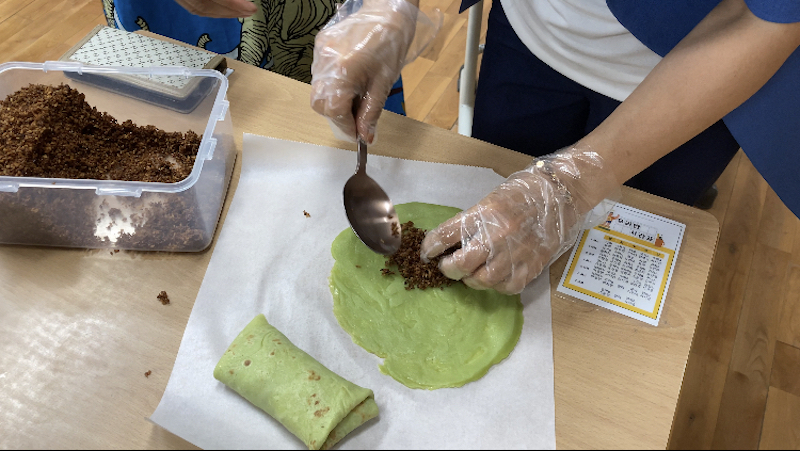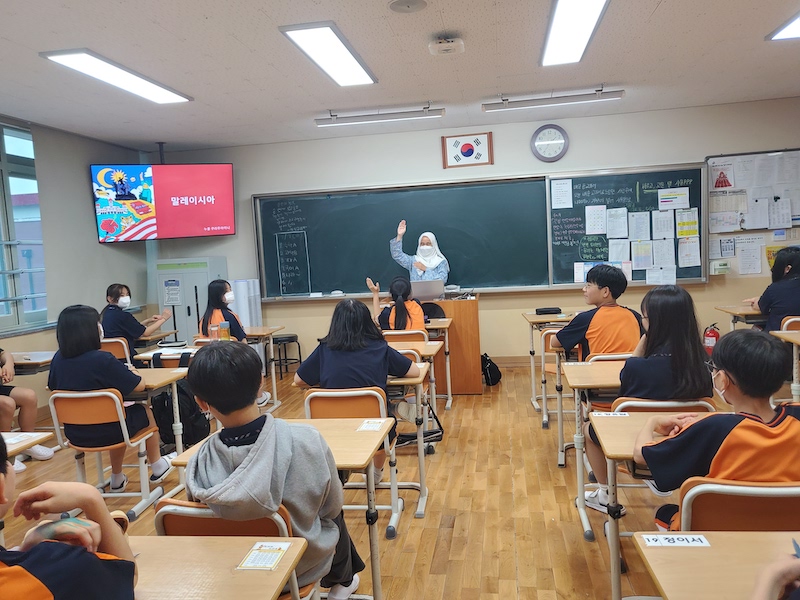Culture Exchange: Teaching Culture Classes at Unri Middle School
By Qurratu
It is said that summer vacation is one of the best times during one’s university life. Some went on holiday, others took extra classes to earn more credits, and as for me, one of my activities during this two-month school break was teaching culture classes. It is a one-day freelance job introducing things like Malaysian culture and food to Korean middle school students. Using the class as a platform, I got the opportunity to meet with respectable foreign teachers from Japan, Australia, Syria, and many other countries. All of them had resided in Gwangju for multiple years and, throughout our classes, they shared lots of insights about the city.
Before the class was held, local and foreign teachers gathered and discussed how we should design our program. I was paired up with Mrs. Oh Mi-sook, who guided me very well, especially in preparing my slides since they need to be able to catch the attention of 15-year- old students. Not only that, but to make the Malaysian class the most exciting among the ten countries, we cooked traditional Malaysian snacks made of coconut and palm sugar, known as Kuih Ketayap, together with 28 students. Although it was quite a hassle, as preparing food requires lots of work, Mrs. Oh handled it well, and I could not imagine proceeding with the class without her. The class only lasted for 90 minutes, but in that short period, I learned numerous life lessons.

Importance of Culture Exchange
1. Opportunity to explore other cultures, traditions, customs, beliefs, societies, languages, and much more (Kanakia 2020).1
South Korea is largely an ethnically homogenous country, and it is a rare opportunity to meet and sit around with people who are not Korean. Thus, having a culture class with international teachers is a golden chance for the students to get to know about other nations’ cultures and traditions. As students are exposed to world cultures, it can also be a spark for them to study abroad and explore more around the globe.
2. Bringing unity among diversity (Naik 2020).2
Prof. Niraj Naik mentioned that international education gathers together participants who can make discoveries together, and that there is a multitude of similarities that exist between us all. Exchanging cultures allows us to understand that we are merely trying to figure out life despite having different backgrounds. This value is a salient one, as everyone is simply a human being, and this helps us take the first step towards unity.
Benefits to the Students and Teachers
1. Develop communication and problem-solving skills
By getting to know about other cultures, we get to embrace the differences between us with open arms and acknowledge the things that we need to compromise on. With cultural differences and the pressure of “when in Rome, do as the Romans do,” we got no choice but to alter our brain chemistry in improving communication and problem-solving skills, which helps us avoid making any mistakes and enjoy diversity to the fullest. After all, communication is the key.
2. Never Worry About Mistakes
No one is checking our grammar when we are talking. During the culture class, students were encouraged to talk in English. Even though most of them were not very fluent in it, for sure they were very confident with their skills. Foreign language is all about confidence, and with a little practice, you are good to go!
Furthermore, what I learned from teaching a culture class at Unri Middle School is speaking in the local language will greatly help in communicating. I cannot deny the fact that English is a global language, but my speaking in basic Korean during the class somehow made the students feel a lot more comfortable, and we got to chat easily. Other than that, when preparing for the class, I realize that it takes a long time to get anything done. Koreans are known for their carefulness, planning, and oriented decision-making. It seems simple to decide what traditional Malaysian games need to be presented, yet it took quite some time in getting the final word from the supervisors since everything is calculated.
Above all, a huge thanks to Mrs. Kang Dan-bi, a coordinator of mine from Chonnam National University who always took good care of me and for introducing me to this job. I should not forget to mention Mrs. Yang Hong-sook, president of the World Culture Experience Center, for entrusting me to deliver the company values of building a bridge between countries. Of course, there were language barrier issues here and there, but with a little Korean proficiency on my part, the class managed to go well. It was also eye-opening to me, as I want to salute educators out there because the teaching profession is not as easy as it seems.
Sources
1 Kanakia, R. (2020, December 16). An overview on the cultural exchanges. Ipleaders. https://blog.ipleaders.in/overview-cultural-exchanges/#:~:text=Cultural%20exchanges%20provide%20an%20opportunity,increases%20the%20tendency%20of%20acceptance
2 Naik, N. (2020, September 22). Benefits of internalization, education, and cultural exchange. InterNepInd. https://internepind-eplus.eu/benefits-internationalization-education-cultural-exchange/
The Author
Qurratu is a 20-year-old university student who is eager to explore countless cultures in the world. Also, she is very grateful for having the chance to experience Korean work culture, which will surely be an asset when entering society in the future.







